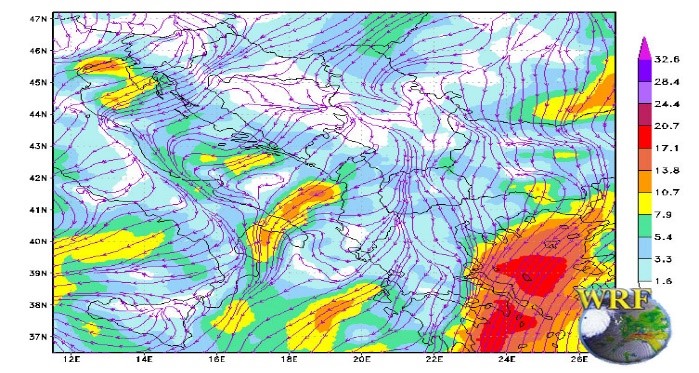Verification of the Temperature, Wind and Precipitation for the High-Resolution WRF-NMM model over the complex terrain of Montenegro

THE PROBLEM/CHALLENGE
Terrain in Montenegro varies from high mountain systems (up to 2543m altitude) in the northern part of the country, through karst segment in central and western part, to the Adriatic Sea. Montenegrin relief defines rapid altitude change in in the coastal area, numerous karst fields, basins, river valleys, unique canyons, large areas of natural and artificial lakes and biodiversity specifics, on a relatively small terrain. Precisely predicting atmospheric phenomena shows an exceptionally difficult task.
Institute for Hydrometeorology and Seismology (IHMS) and NCC Montenegro tested weather prediction WRF model with NMM core. The Weather Research and Forecasting (WRF) Model is a next-generation mesoscale numerical weather prediction system designed for both atmospheric research and operational forecasting applications. It features 2 dynamical cores: data assimilation system and software architecture, supporting parallel computation and system extensibility. The model serves a wide range of meteorological applications across scales from tens of meters to thousands of km.
Verification was performed comparing WRF NMM predicted values and measured values for temperature, wind and precipitation for six Montenegrin weather stations in a five-year period using statistical parameters. The difficult task of adjusting the model over the complex Montenegrin terrain is caused by a rapid altitude change in the coastal area, numerous karst fields, basins, river valleys and canyons, large areas of artificial lakes on a relatively small terrain. The subject of the research are meteorological measuring stations located in the cities of: Žabljak, Pljevlja (north of Montenegro- mountain area) as well as the Golubovci (near Podgorica), Niksic, (central area of Montenegro) and Bar, Tivat (south of Montenegro – costal area).
SOLUTION:
The WRF model is used for weather prediction on IHMS cluster on daily basis and on smaller cluster with poorer quality performance. Model is installed on Yotta HPC cluster as on virtual lab, adjusted for MNE purposes and HPC infrastructure. Newest installation on the HPC cluster, supported by NCC MNE, enabled IHMS to improve precision and prediction and to compare WRF model with other models used for MNE weather prediction.
The data sources used in analysis are eight-hour data reports. By decoding, filtering and sorting them, a database of eight-hour meteorological quantities was created which will be used during verification for each of the stations.

Mean difference temperature heat map. Shades of blue means underestimation of model while the red shade shows overestimation of modelled temperature.
Basic meteorological parameters of temperature, wind and precipitation and the performance of the model will depend on the time of day, the season, the altitude of the station, as well as the surrounding relief of stations, for which the model results were verified. After obtaining prognostic meteorological parameters for 24 hours in advance, a database of hourly modelled and eight-hour temperature values, at a height of 2m and wind speed at a height of 10m was created, while precipitation was summarized in twelve-hour intervals, i.e. from 6 a.m. to 6 p.m. and from 6 p.m. until 6 a.m. the next day. The timeframe on which data was collected for further processing is 5 years, i.e. from 2017 to 2021. The necessity of setting up high-resolution models is essential to timely forecast dangerous meteorological phenomena. Institute for Hydrometeorology will adjust WRF NMM model for national prediction according to results/verification of HPC simulations. Based on the obtained verification results, it has been proven that WRF NMM model is a good solution for weather prediction in Montenegro.
BENEFITS:
- Speed-up of numerical weather prediction with increased computational capacity.
- Enabling and enhancing more accurate weather intelligence and modelling.
- Potential business impact could be explored and verified thanks to more precise weather forecasting/intelligence services, also on localized level and through multiple applications related to: smart agriculture, tourism activities, green energy, maritime, optimized/safe transportation etc.
CONTACT:
EUROCC Montenegro
National Competence Centre for High-Performance Computing
University of Donja Gorica
Oktoih 1, 81000 Podgorica
Montenegro

